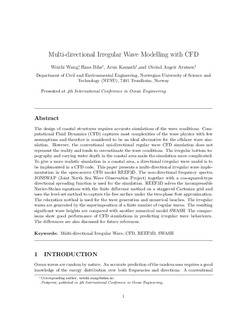Multi-directional Irregular Wave Modelling with CFD
Chapter
Accepted version

Åpne
Permanent lenke
http://hdl.handle.net/11250/2588811Utgivelsesdato
2019Metadata
Vis full innførselSamlinger
Originalversjon
10.1007/978-981-13-3119-0_31Sammendrag
The design of coastal structures requires accurate simulations of the wave conditions. Computational fluid dynamics (CFD) captures most complexities of the wave physics with few assumptions and therefore is considered to be an ideal alternative for the offshore wave simulation. However, the conventional uni-directional regular wave CFD simulation does not represent the reality and tends to overestimate the wave conditions. The irregular bottom topography and varying water depth in the coastal area make the simulation more complicated. To give a more realistic simulation in a coastal area, a directional irregular wave model is to be implemented in a CFD code. This paper presents a multi-directional irregular wave implementation in the open-source CFD model REEF3D. The non-directional frequency spectra Joint North Sea Wave Observation Project (JONSWAP) together with a cos-squared-type directional spreading function is used for the simulation. REEF3D solves the incompressible Navier–Stokes equations with the finite difference method on a staggered Cartesian grid and uses the level-set method to capture the free surface under the two-phase flow approximation. The relaxation method is used for the wave generation and numerical beaches. The irregular waves are generated by the superimposition of a finite number of regular waves. The resulting significant wave heights are compared with another numerical model SWASH. The comparisons show good performance of CFD simulations in predicting irregular wave behaviours. The differences are also discussed for future references.